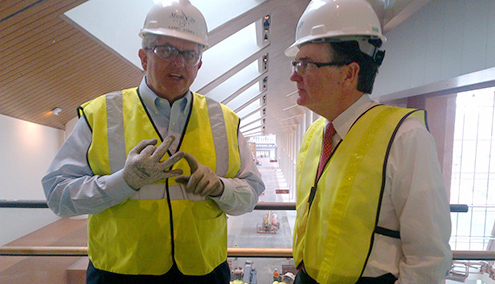
Photo by Kendrick Disch
A recent event for educators sponsored by the Atlanta Fed and hosted by the Tennessee Bankers Association in Nashville focused on developments in the Tennessee and Nashville economies.
As any visitor to Nashville can attest, the city is booming. The metropolitan area added more than 200,000 residents between 2010 and 2014, according to the U.S. Census Bureau.
Nashville's skyline bristles with construction cranes, as in-migration is boosting development of hotels, office buildings, houses, apartments and condos. New hotels and meeting facilities are attracting conventioneers, and the music scene is attracting more and more tourists. Nashville's other main economic drivers—auto manufacturing and healthcare—continue to grow as well.
"There's a lot of excitement in the region about the rapid acceleration in investment activity and the unprecedented inflow of people, both tourists and new residents," said Lee Jones, regional executive of the Atlanta Fed's Nashville Branch.
Like a strong rhythm section, new residents are driving the beat of Music City's housing market. Nashville-area home sales were up 12.2 percent in the first half of 2015 compared to the same period in 2014, according to the Greater Nashville Association of Realtors. In June, the median price of a home sold in Nashville was $240,000, up from $222,000 a year ago. And because of the healthy housing sector, construction employment is growing handsomely, up close to 12 percent in June compared to last year, according to the U.S. Bureau of Labor Statistics (BLS).
Jones noted that the area's rapid development He added that also creates challenges. "Leaders must find a way to ensure that the growth is sustainable, that the city's infrastructure can keep up with growth, and that the rapid progress isn't leaving anyone behind," he said.
And then, of course, there's the music
The 2015 Country Music Association Music Festival (CMA Fest) in June attracted a record number of visitors and related sales. Spending by fans with tickets increased to $46.8 million, a nearly-20 percent substantial improvement over last year's $39.3 million.
 Dennis Lockhart, president of the Federal Reserve Bank of Atlanta (right), and Larry Atema of the Nashville Convention Center Authority toured the Music City Center while it was under construction.
Dennis Lockhart, president of the Federal Reserve Bank of Atlanta (right), and Larry Atema of the Nashville Convention Center Authority toured the Music City Center while it was under construction.The Music City Convention Center, open for just over two years, hosted 305 events with 676,060 attendees from April 2014 to April 2015, generating $392.2 million in economic impact, according to the center's figures. The Music City Center portion of tax collections is up 22 percent year over year through April 2015. The influx of visitors has generated ample job creation: leisure and hospitality employment for the Nashville region increased more than 7 percent in June compared to the same time last year, BLS data show.
Healthy job growth fuels economy
Meanwhile, manufacturing in middle Tennessee is clearly benefiting as auto sales accelerate across the country. Employment in durable goods manufacturing in the Nashville metro area—which includes the cities of Smyrna and Spring Hill, home to Nissan and General Motors plants—is up over 5 percent year over year in June.
Health care employment also remains strong, up 3.8 percent. The Nashville health care industry contributes nearly $30 billion and more than 200,000 jobs to the local economy annually, the Nashville Health Care Council reported in its 2013–14 annual report.
Overall job growth in the Nashville metro area was up 3.6 percent in June compared to a year earlier, a rate that compares favorably to the 2.2 percent pace of job growth posted by Tennessee and the 2.1 percent national rate of increase. BLS data also show that Nashville's unemployment rate is tracking below both that of Tennessee and the nation (see the chart).
"I believe the underlying fundamentals are strong enough to propel the economy along a growth path that delivers a bounce-back in the second quarter followed by a resumption of a pace of growth between 2.5 and 3 percent."
FRB Atlanta President Dennis Lockhart
Given these strong trends and a sunny forecast for growth at the national level, the outlook for the Nashville area looks solid. Indeed, confidence in the local economy among the region's consumers hit its highest level in 11 years this spring, and expectations also rose, suggesting that people are more optimistic about the economy over the near term.
Helping teachers teach
The discussion of Nashville's economy was part of "An Evening with the Fed" event held in that city. About 100 educators from middle Tennessee networked, explored current economic and financial topics, and gained tools to teach students to translate theory into real-world lessons.
"The 'Evening with the Fed' programs deepen my understanding of current economic conditions by informing us on all the factors involved," said Holly Yates, a social studies teacher at Nashville's Antioch High School. Yates said she feels that news media focus only on a couple of sound bites, without fully explaining the reasons for decisions nor the meaning of the numbers. "I use the information that I receive at 'Evenings with the Fed' in current events discussions with my students, and feel better equipped to explain economics and current economic conditions to my classes," she added.
Sherri Rogers, a business technology teacher at Oakland High School, said she also found the material easy to understand. "It contained interesting, relevant statistics that I plan to share with both my banking and IB [International Baccalaureate] business management students."
During the evening, Atlanta Fed officials and educators also discussed what jobs would be available for their students once they enter the workforce. The Tennessee Department of Labor and Workforce Development issued a report on occupational projections, which recognized the expected growth of services employment, especially health care, business services, and leisure and hospitality in the state.
Challenges remain
Several educators noted that while broad indicators of economic activity may be positive, many challenges remain for Tennessee's low- and middle-income population. The Atlanta Fed is actively studying this issue.




